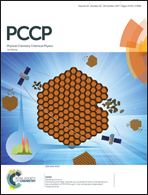Hydrogenous spinel γ-alumina structure†
Abstract
The structure of γ-Al2O3 is still under debate. Here we report a H spinel structure evolved from pseudo-boehmite. A unit cell with two octahedral cationic vacancies and one bulk H was preferential in terms of calculated Gibbs energy, which was well consistent with experimental data. Bulk H was found to migrate out with elevated temperatures. Through calculating the migration barriers of every step, we observed that the “hopping” step was rate-determining. The hopping rates were further estimated by assuming a Boltzmann distribution of energies, and as a result they increased by 2 to 3 orders of magnitude from 500 °C to 800 °C. This investigation will encourage us to study more uncertainties in material structures.



 Please wait while we load your content...
Please wait while we load your content...